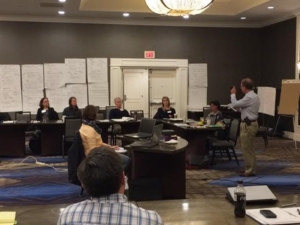
Rachel on a boat. Credit: Rachel Dixon
Rachel Dixon, long-time coordinator for the Scientific and Technical Advisory Committee (STAC) recently left CRC to pursue a PhD at the Virginia Institute of Marine Science (VIMS).
“My time at CRC and STAC encouraged me to remain within the region in some capacity, so thankfully I can keep working on issues pertaining to the Chesapeake Bay and its natural resources,” said Dixon. “This fall, I am returning to graduate school to pursue my PhD, where I will be working with Dr. Mary Fabrizio in the fisheries department.”
She added, “this opportunity will allow me to build toward my long-term interests in conducting research and teaching in marine biology – while incorporating my newfound perspective on applied, management-relevant science! I’m very excited for the new challenges and opportunities this next chapter will bring.”

Foreshadowing: STAC and CRC staff visit to VIMS campus in June 2015; before Dixon knew she’d be a student there.
Dixon joined the staff of CRC/STAC in 2014, becoming the STAC coordinator in 2016. “CRC had recently expanded the STAC team to be able to accomplish the long list of tasks and technical reviews to support the Chesapeake Bay Program’s scope of work for the upcoming TMDL Mid-Point Assessment in 2017,” she explained.
Bill Ball, soon-to-be-retiring CRC Director, noted that his and Rachel’s tenures almost completely overlapped at CRC. “Little did I know that, within a year and a half, I would be counting on Rachel not only to continue to help with planning and editing nine different STAC technical reviews (eight of which were associated with the 2017 TMDL mid-point assessment), but also to help complete over 30 different STAC reports and to find and hire three new STAC staff,” said Ball.

Dixon, middle, during a STAC workshop. Credit: Christine Gyovai
While coordinating STAC, Dixon was in charge of organizing many STAC workshops, which she named as her favorite part of her job. “One of my favorites was a 3-day workshop I organized in 2018 on ‘Chesapeake Bay Program Modeling in 2025 and Beyond,'” she explained. “The planning process took over a year of collaboration with the steering committee and brought in nearly 70 participants from different topic areas, so it was incredibly rewarding to see it all come together.”
Dixon was able to build a network of colleagues and friends during her time at CRC. “Having an opportunity early in my career to meet, interact with, and learn from experts in a wide range of fields, positions, and organizations was a really invaluable experience,” she said. “STAC, CRC, and the partnership as a whole are comprised of truly hard-working and dedicated individuals who really showcase what can be accomplished when we all pull in the same direction.”
Ball exclaimed that Dixon will surely be missed as a member of the CRC team. “No one I know was more dedicated and hard-working toward keeping STAC running smoothly,” he said. “Rachel had just the right combination of professionalism, practicality, and unflappability that was required to foster good partnerships and effective collaboration. We at the CRC (and STAC!) simply cannot express how much we will miss her, even while wishing her all the best in her doctoral studies and future career.”
